Ann Mah's Blog, page 28
August 4, 2011
Eggs in a nest
My dad is an excellent cook. He can make anything taste delicious. He's also taught me some very important cooking lessons, things like: Just because you want to get rid of that last bit of cilantro before if turns brown and slimy, doesn't mean you should throw it all into your guacamole. Together, we've been known to throw a Chinese dinner party or two, as this here blog has documented.

On a trip to London last month, I learned how to make one of my Pops's favorite fusion starters — tea eggs in a nest of julienned vegetables. I'm delighted to share it with you now, mes amis!


Start with a bevy of speckled quail's eggs — aren't they pretty? — about 30 of them. After you've hard-boil-cooked the eggs, you crack the shells and then simmer the eggs again, this time with a handful of loose black tea, a few star anise pods and a dash of dark soy sauce.

Here's what the eggs look like once they've been cooked in tea. Allow them to sit in this liquid overnight, or, even, if stored in the fridge, for a few days. This step is important because it allows the dark cooking liquid to seep across the surface of the egg, creates a lovely marbled effect.

When you're ready to serve the eggs, gently peel them. Toss a salad of finely julienned daikon radish and carrot with a sesame vinaigrette. Create a nest of vegetable salad on each plate and nestle the eggs — we served three to a person — on top before adding a sprinkle of sesame seeds.

Pops has been making this entrée for years, but because he's an inventive cook, it keeps evolving. I really love this latest incarnation, a plated first course, with the nest surrounded by cool cubes of tofu salad (which is another recipe for another day).
Quail tea eggs
Serves 10
30 tea eggs
3 tablespoons loose black tea
1 tablespoon dark soy sauce
8-10 star anise pods, either whole or the equivalent in bits
2 cups water
Place quail eggs gently in pot with two cups water or enough to cover eggs. Bring to boil, lower heat, and simmer for 10-15 minutes until eggs are good and hard. Rinse under cold water to cool. Crack each egg by tapping all around with a teaspoon or rapping on its sides as you turn it. Return the eggs to the pot.
Add 2 cups water again. Then, add rest of ingredients — tea, soy, anise — and bring to boil. Lower heat, and simmer for a good hour or more with lid on. Turn off heat and let stand overnight or transfer everything (eggs, liquid, tea, anise, etc.) to a small container and refrigerate. May keep this way for at least three or four days in fridge.
The day of using the eggs, carefully peel off the egg shell. You will find a beautiful marbling effect on the surface of the eggs where it contacts the shell.
The actual work time, not including cooking time is very quick … about ten minutes. The unknown work time is in the peeling of the eggs.
Julienned vegetable nests
1 daikon, peeled
1/4-1/2 carrot, peeled
2-3 green onions
Sesame vinaigrette
1/2 cup white sugar
1/2 cup white vinegar
2 tablespoons high quality sesame oil
Salt (if needed)
Finely julienne the daikon for the base, add a bit of julienned carrot for color, and some finely sliced green onions. Toss the vegetables with a few tablespoons of vinaigrette, adding more if needed.

August 1, 2011
Truth and fiction (and a giveaway)
Bonjour, mes amis! I'm so delighted to welcome novelist Sheila Kohler whose books include Becoming Jane Eyre, Cracks, and, most recently, Love Child. A professor of writing at Bennington College and Princeton University, Sheila is a needle-sharp observer, the type of writer whose work creeps under your skin long after you've put the book down, a novelist who receives five-star Amazon reviews from Amy Tan ("Stunning! A master of suspense"). I was thrilled to talk to Sheila about the connection between human psychology and great writing, and finding answers through fiction.
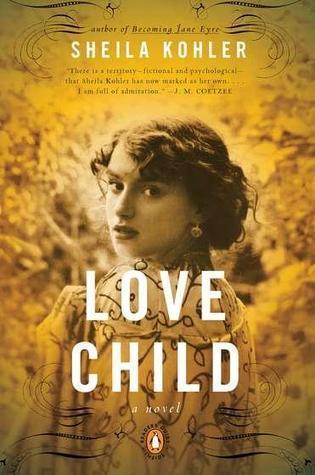
What inspired your newest novel, Love Child?
Love Child is a very autobiographical novel in the sense that it is based on my mother's life. When she died, a wealthy woman, she did not leave her fortune to her only remaining daughter — me! When I told people about this they seemed so surprised and shocked that I thought it would be good material for fiction. Of course, I wanted to find out why, too. I think fiction often comes from a question that one tries to answer on the page. And I think I did. By the time I had finished writing the book I felt I understood my mother much better and had much more sympathy for her — though of course much is imagined. My mother was a very mysterious woman.
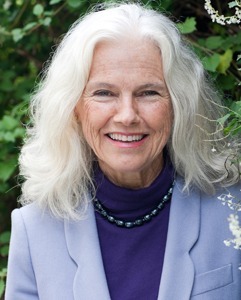
You have a Masters degree in psychology. How have your studies helped or hindered you as you develop characters and stories?
Oh, I think any knowledge we can acquire about the human mind helps us with fiction. People read, after all, partly at least, to find out about themselves, to find themselves on the page. The great writers are always amazingly perceptive about human nature, it seems to me. My studies have been very helpful and perhaps particularly when describing pathological states of mind as I did in Crossways for example.

You've said that your writing took a new turn 25 years ago when your sister died under violent circumstances in apartheid South Africa. How did these events affect your work?
Again, I often write to try to understand something, to find the answer to a question. In the case of my sister, who was, I believe, murdered, I tried again and again in several books to understand how this could have happened to her, someone who seemed so loving, generous, and innocent.

You were born in South Africa, which is also the setting for Love Child. How does your birth country inspire you? What are some of your favorite books about South Africa?
South Africa is such a beautiful country but at the same time a strange one. There was such a contrast between the beauty of the land and the underlying violence of the divided society during the apartheid period. I think this is something that inspired my work: both to try and reproduce in words the brilliance of the light and the beauty of the flora and fauna and also to understand the undercurrants of violence in this society. I'm a great admirer of J.M. Coetzee's work and particularly of his great book, Disgrace.
J.M. Coetzee has said of Sheila's work "There is a territory — fictional and psychological — that Sheila Kohler has marked as her own. I am full of admiration." Are you curious to dip into one of her rich and darkly complex novels? Thanks to Sheila's publisher, Penguin, I'm thrilled to be giving away a copy of Love Child. To enter, leave a comment below. The winner will be chosen at random Friday, August 5, 2011.
(Bottom images from United Nations Photo and Pinzur.)

July 28, 2011
Guernsey

I missed a blog post last week, which doesn't make me happy, but I do have an excuse. See, I was traveling, away on a wild island in the midst of the English Channel. Located about 30 miles off the coast of France, Guernsey is a mix of craggy coastline, green pastures and the quaint cobblestone streets of a Cornish fishing village. I loved every salty, sea-breezy minute.

Traveling to Guernsey from Paris takes several hours and involves a multitude of public transport. First you take a train to St-Malo (three hours), then a taxi to the Gare Maritime, then a two-hour ferry ride through choppy Channel waters to Saint Peter Port, Guernsey's capital.

But when you arrive, you're rewarded by the sight of an adorable harbor bobbing with sailboats and the roofs of St Peter Port rising above.

I loved strolling the cobblestone streets of St Peter Port, a town filled with secret staircases and curved Victorian lamp posts and tiny winding streets leading to the sea.

One damp afternoon, I took a walk along the cliff top, hiking through wooded paths with the sound of waves filling my ears. When I turned a corner, glorious Fermain Bay appeared below, shrouded in mist.

Guernsey is famous for its cows, cream, tomatoes, and off-shore banking. But maybe you've heard of it because of The Book (as it's known here), the bestselling novel, The Guernsey Literary and Potato Peel Pie Society, which is takes place on the island just after WWII. Can't you imagine the heroine, Juliet Ashton, bicycling down this country lane?

Or the group meeting in this old-fashioned farmhouse to discuss The Canterbury Tales?

On my final morning, buttery sunshine flooded the island, making it hard to say goodbye. I'd love to come back to this wild, isolated place.

July 26, 2011
Weddings
I've been thinking about weddings recently, and not just because of all the recent celebrations in New York, which I've loved reading about in the paper. You see, eight years ago today, on a sunny, summer afternoon in Southern California, Chris and I joined together in civil matrimony. Yep, we got ourselves hitched.
It was a beautiful day of laughter, sunshine, California sparkling wine, and family and friends who gathered from the world's four corners to wish us well. Their love transformed the hotel where we got married from a wedding-industrial complex into someplace magical.

One my favorite parts about our wedding were the flowing bottles of Mumm Cuvée Napa Valley, which is one of the loveliest wineries I've ever visited. But if I could do it all over again, I think I'd also propose a special cocktail to mark the occasion. And I have just the one in mind.

It starts with chili vodka, or chili-infused vodka (recipe below), which packs a deep and gentle burn. Mix it with ice, lemonade and club soda, and you have a tart and refreshing drink, with a persistent, pleasant under note of heat. Kind of like marriage itself? Hm, let's not read too much into this recipe.

These cocktails, which my husband has named The Calcutter, would be lovely on a summer evening, accompanied by a flip through your wedding photo album.
Chili Vodka
1 700ml bottle of vodka (I used Absolut)
4-5 chilies (depending on their strength)
Slice the peppers lengthwise and pop them in the vodka bottle. Allow to infuse at room temperature for two days, gently agitating the bottle every evening (if you remember). After two days, taste the vodka — it should have a deep, gentle burn. If it's not adequately spicy, allow to infuse for a few another day or so. If it is hot enough, remove the chilies. The heat index will depend on the strength of your peppers. I used 4-5 green finger chilies, but if using habaneros or jalapeños, proceed with caution.
Calcutter cocktails
2/10 chili-infused vodka
3/10 lemonade
club soda
lemon slices
ice
Pour the vodka and lemonade in a tumbler filled with 3 large lumps of ice. Add club soda to almost the brim and garnish with a slice of lemon.

July 18, 2011
Canine companionship
Bonjour, mes amis! I'm so excited to welcome author Allie Larkin to chat about her debut novel, Stay. The book is about Van, a lovelorn young woman who, while drowning her sorrows with a few cocktails, accidentally buys a German shepherd puppy off the internet. Mayhem ensues, but in the end, could a dog named Joe possibly be the cure for a broken heart? I sat down with Allie to chat about unconditional dog love, real-life canine inspiration, and her favorite books about dogs.
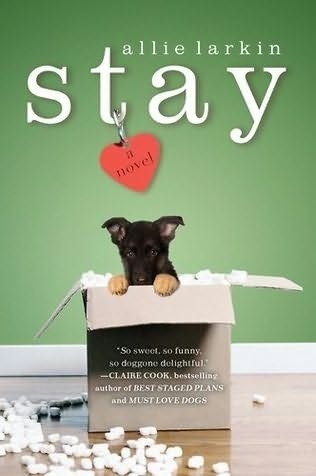
Where did the idea for this book come from?
Stay started as a writing exercise in my senior creative writing class in college. I sent the story out and got some good feedback, but no bites. A few years later, I went back to it, just intending to polish it up and send it out again. Something wasn't working, but I didn't know how to fix it. I decided to write a scene as something of an outtake, in the hopes that it would influence my story if I knew more about my characters. And that's where Stay starts. Eventually, I realized I wasn't writing a short story anymore.


How did you create the character of Joe, the book's 100-pound German shepherd puppy? Is he based on a real dog in your life?
Joe is the only character I've ever written that is based on a real being. Our dog, Argo, was the inspiration for Joe (and the cover model for the hardcover). Argo is from the Catskills, not Slovakia, and he wasn't the result of a drunken buying spree. But he did change my life. Argo has taught me so much about unconditional love and friendship. I laugh every day, and I'm a better person because I get to share my life with him. I wanted that for Van, but I knew she'd never go about getting a dog the right way. She needed one to just kind of appear in her life.
Joe has the same open-heartedness that Argo does, and many of Argo's mannerisms, but Argo transitioned into living with us very easily. When we adopted Stella, I found the perfect muse to help me create some of Joe's more difficult moments. She has since settled down and stopped chewing everything in sight, but we had some inspiring incidents before she relaxed. Stella, by the way, is the subject of an essay that will be published this fall in the anthology, I'm Not the Biggest Bitch In This Relationship.

How does Van, your main character, benefit from her canine relationship?
Van was so stuck in her life. She had put herself in a place where she was very alone and wasn't doing anything to change that. When she orders Joe, he gives her a family. She's not alone anymore. There's something amazing about the unconditional love we get from dogs. Joe makes it easier for Van to put herself out there, because no matter what happens, she'll go home to a dog who loves her and is happy to see her. And, of course, there are those trips to the vet…

What are your favorite books about dogs?
I love Must Love Dogs by Claire Cook and Alison Pace's books. When I was younger, I loved Call of the Wild and Julie of the Wolves. I had a fascination with the very real relationships people have with animals. Actually, I still do.
Lovely, funny, heartfelt, Stay is a novel about real relationships — male/female, human/canine. Curious? I'm delighted to give away a copy thanks to Allie's publisher, Dutton! To win, leave a comment below with your favorite pet name (real or imaginary). The winner will be chosen at random next Friday, July 22.
(Top photos from Allie Larkin, bottom photo from Alice Jamieson.)

July 15, 2011
Liberté, fraternité, rosé
France celebrated its birthday yesterday with a military parade, picnics, fireworks and lashings of rosé wine, bien sûr. What did I see?

There were armored vehicles and soldiers keeping a close eye on the 6e arrondissement…

A picnic on a gorgeous, bright and breezy summer evening on the Esplanade des Invalides, organized by podcast hosts extraordinaire, Katia and Kyliemac…

Croque Camille's crunchy, cool coleslaw made with red cabbage and blue cheese, and a scoop of her famous potato salad…

And a fleet of helicopters rising above Invalides and high into the sky…
It was a lovely day of celebration for the Hexagon, mes amis! And now, whether you're in France or beyond, I hope your weekend is equally filled with good friends and good food!

July 11, 2011
Lunch

Lunch is the one meal of the day that's guaranteed to make me sleepy. As a result, I try to eat very light, almost vegan, lunches of fruits, vegetables and whole grains during the week. And, I have to admit, I usually eat them in front of the computer. Bad, barbaric me.
I find lunch habits fascinating, so I was intrigued when I read this article from The Independent (UK), which contrasts the British and French midday meal. Last month, an International Criminal Court lawyer poked fun at the leisurely two-and-a-half hour lunches enjoyed by his French colleagues — who reacted quite defensively.
From my personal experience, I can say that my former French colleagues took an hour for lunch and they truly used every minute. Perhaps they ate in a café, or a sandwich in the park, or warmed leftovers in the kitchen, or read a book, or went for a long walk – but they never ate in front of the computer. According to this study, 60% of French people lunch in restaurants, taking an average of 38 minutes to eat it.
What do you usually do for lunch, mes amis? I'm so curious to know!
(Thanks to Rhino75 and PH de Baecque for the links.)

July 7, 2011
Maine Coon cats

Last weekend we were in London where we visited some friends for dinner and fell under the spell of their Maine Coon cats, the fluffiest pair of felines to ever have clawed a scratching post (not pictured here, alas — I forgot my camera). I was totally enchanted by their size and sweeping tails and fuzzy ears.

Once I got home and consulted my research assistant, I learned that Maine Coons are not only excellent hunters, friendly, and highly intelligent, but — despite their king-of-the-wild-frontier name — they also (might) have a connection to France!

See, back in the 1790s, when Marie Antoinette was hoping to flee France, she enlisted the help of one Samuel Clough, a ship captain from Maine. She (and/or her loyal royalist servants) loaded up her prized possessions onto Clough's ship, including a furry group of favored Turkish Angora kitties. Though Marie Antoinette never made it to Maine, her cats managed to immigrate. They bred with local short-hair felines and thus the Maine Coon cat breed was born. Or so the story goes.


And they like books! Who wouldn't love a cat who reads?
(Top photos from roos2007, bottom photo from Mr T in DC.)

July 5, 2011
Peking duck de "Mah" façon

I'm going to tell you a secret, mes amis. When we make Peking duck in the Mah family, we don't grab an axe and head out to the duck farm to slaughter, pluck, gut, scald, dry, pump with air, glaze, and roast our very own bird. No, our recipe for duck involves a trip to…

Chinatown. Here, we pick up a pre-cooked duck, bring it home, and doctor it up. This weekend, I was lucky enough to get a duck tutorial from my dad and I'm so excited to share his special method with you…

Heat the oven to 150ºC/300ºF. Cut the pope's nose off your bird, and arrange the duck breast-side down on a rack over a shallow tray. Add a cup or so of water to the tray (to prevent the dripping fat from smoking up your kitchen).


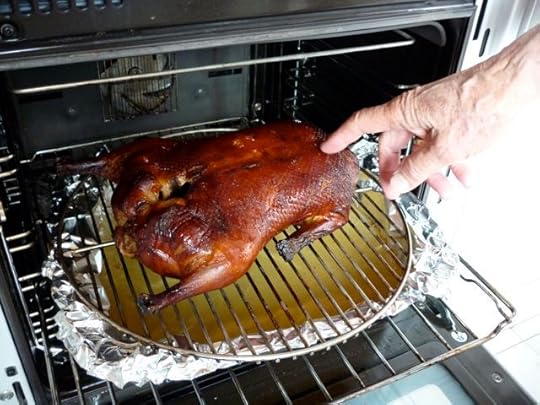
After 1 1/2 hours, flip the duck so the backside is down, and continue cooking for another hour. Poke the breast — the skin should have tightened slightly. Remove the duck from the oven. The goal is to render the fat so that the skin slips easily from the meat. But be careful: you don't want it to darken too much. Allow the duck to cool completely, and then, with a sharp knife, cut and slide the skin off in one single piece (if possible). Place the skin on the rack over the tray (again, with water in it) and back in the oven at 150ºC/300ºF, until the skin is crisp, like well-cooked bacon (about 30 minutes).

Carve the duck, and cut the crisped skin into squares with the help of kitchen shears.

Serve with duck pancakes (available in the frozen section of your Chinese supermarket), duck sauce (half hoisin, half plum sauce) slivers of scallion and cucumber, and cilantro leaves.

June 30, 2011
Dreamy kitchens

After years of saving our pennies, we're finally taking the plunge and buying an apartment in Paris, a postage stamp that we can call our very own. And now that I've viewed many (many, many) apartments, I can say with some confidence that whatever and wherever we end up buying, we'll need to do some renovations. Like a total kitchen transformation. Gulp. I feel a little like a lamb being led to the slaughter by a team of contractors, plumbers, electricians and painters.
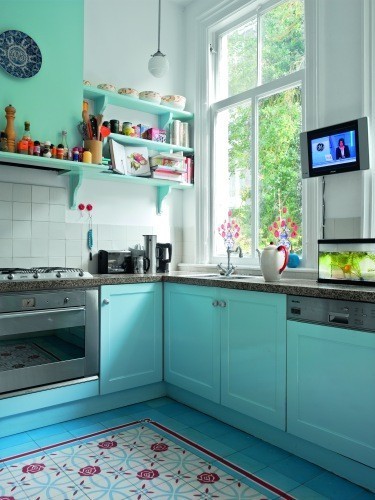

Kitchens are funny places. We spend so much time in them, we want them to be beautiful. Yet they're also the most functional room of the house, full of equipment and appliances — especially in France where the laundry machines are often found next to the dishwasher.
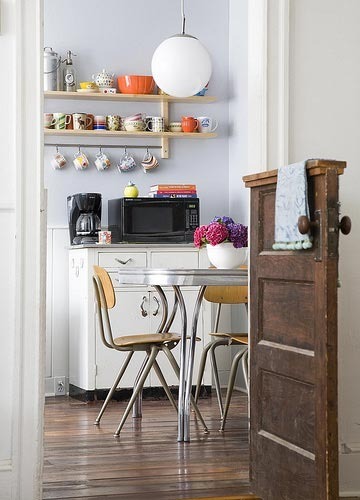
Beautiful, functional, space-saving, and unique is a lot to ask from a small room. I've been scouring books and blogs for budget-friendly ideas for tiny kitchens and my mind is seriously boggled. And so I'd love to ask you, mes amis — do you have any favorite design websites? I'd love to hear your sources for home inspiration!
(Top photos from Casapinka, bottom photo from Apartment Therapy.)




